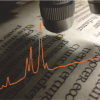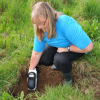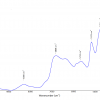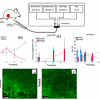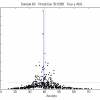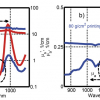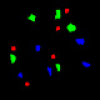Anna Serdyuchenko, Victor Gorshelev, Mark Weber and John P. Burrows
Institute for Environmental Physics, Bremen University, Otto-Hahn Allee 1, 28359 Bremen, Germany. E-mail: [email protected]
Introduction
In this article, we report on the research to improve our knowledge of the ozone absorption cross-sections. This is required for active and passive remote sensing applications yielding the total column and profiles of ozone. New laboratory measurements provide data for a wide spectral range in the ultraviolet (UV), visible (vis) and near infrared (NIR) regions at a spectral resolution of 0.02 nm. An absolute accuracy of about 3% or better and wavelength accuracy better than 0.005 nm throughout the spectral range have been achieved at 11 temperatures from 195 K to 293 K.
Comparison of the available ozone cross-sections with our new dataset shows good agreement within the uncertainty limits. This new cross-section dataset improves the ozone data quality which is required for stratospheric ozone trend studies and the determination of tropospheric ozone abundance.
Ozone is the most important trace gas in both the stratosphere and the troposphere. The global monitoring of the ozone concentration, using both satellite-borne and ground-based instruments, plays a key role in the determination of the long-term trends for the stratospheric ozone layer, which protects the biosphere from harmful UVB radiation and air quality related studies.
The requirement to measure small changes in stratospheric and tropospheric ozone places strong demands on the accuracy of the ozone absorption cross-sections used in retrievals of the spectra delivered by remote sensing spectrometers. Several satellite spectrometers have been used to measure low-resolution cross-sections pre-flight (SCIAMACHY, GOME and GOME-2 flight models).1,2,3 These datasets have the great advantage of automatically incorporating the instrumental slit functions. However, use of these datasets is not straightforward for other instruments. In the report for the Absorption Cross Sections of Ozone (ACSO) committee, Weber et al.4 consider the impact of cross-section choice on total ozone retrieval applied to GOME, SCIAMACHY and GOME-2 and discuss necessary resolution matching, wavelength shifts and scalings. [The ACSO committee was established by the World Meteorological Organization and the International Association of Meteorology and Atmospheric Sciences to review and recommend ozone cross-sections for all the commonly used (both ground-based and satellite) atmospheric ozone monitoring instruments.]
Among high-resolution datasets, the most important are the so-called data of Bass–Paur5,6 and data of Malicet, Daumont, Brion et al.7 (and references cited therein). Regardless of the high quality of these data, they have serious limitations, leaving room for improvement. Both datasets are based on experimental data acquired at only five temperatures, compelling researchers to use interpolation for other temperatures. In addition, these datasets only cover the limited UV and vis spectral regions.
More details on ozone cross-sections obtained before 2003 can be found in a comprehensive overview by Orphal.8 Relevant data are available, for example, from the online spectral atlas of gaseous molecules of the Max-Planck-Institute for Chemistry, Mainz9 or from the ACSO home page.10
The new accurate broadband cross-sections determined in this study have inherent advantages over the previous datasets to the maximum possible extent. The data were obtained for 11 temperatures down to 195 K. For convenient use in various current and future projects, the new dataset uniquely combines a broad spectral coverage from 220 nm to 1000 nm with spectral resolution as high as 0.02 nm. This dataset enables accurate convolution with the slit functions of all currently relevant ground-based and satellite-based remote sensing instruments.
Experimental methods and instruments
To ensure high resolution, wavelength accuracy and good signal-to-noise ratio over the entire spectrum, the advantages of the capabilities of an echelle spectrometer (ESA 4000, LLA Berlin) and a Bruker HR120 Fourier transform spectrometer (FTS) were combined. Both devices exhibit excellent spectral calibrations, having at least 0.005 nm and spectral resolution from ~0.02 nm [full width half maximum, (FWHM)] in the UV to 0.5 nm at 1000 nm.
Measurements involved three different light sources (deuterium and xenon super quiet gas discharge lamps and tungsten filament lamp) with sufficient stability during the experiment. The echelle spectrometer was equipped with an intensified charge-coupled device (ICCD) matrix detector, with high sensitivity in the UV region, whereas the FTS set-up with Si and GaP semiconductor detectors was mainly used in the visible and infrared spectral regions.
The magnitude of the ozone absorption cross-sections is directly proportional to the optical density, which is the logarithm of the ratio of light intensities attenuated by a cell with and without ozone. Despite the apparent simplicity of the absorption experiment in general, there are several challenges to overcome in order to achieve broadband ozone spectrum measurements with the required accuracy.
First, ozone is an unstable reactive molecule; at room temperature, decay can have explosive characteristics at ozone concentrations as low as 10%. As ozone is explosive, measurements using pure ozone must be accomplished with particular caution and with careful control of temperature and pressure, since accuracy of the absolute cross-section values depends on the precise knowledge of the ozone concentration, homogeneous along the known path length.
Second, ozone cross-section values in the UV/vis/NIR region cover more than seven orders of magnitude, while dynamic range of a single measurement typically allows optical density change of about one order of magnitude. Thus, several absorption measurements had to be made with different combinations of experimental conditions for every temperature.
Experiments were made using a cylindrical double-jacketed quartz cell with two sets of quartz windows, installed on both ends and in the middle of the cell (Figure 1). In addition, White-type multipass optics were installed inside the cell to increase the absorption path length for measurements of weak absorption around 380 nm. The inner cell volume was surrounded by a layer of flowing coolant (ethanol), which is in turn isolated from the ambient air by vacuum. The gas supply system included two ozone generators of different efficiency, a rotary vane pump and several pressure and flow measuring instruments (MKS). The stable gas temperatures down to 195 K (–78°C) were achieved using a special cooling system, consisting of cryostats (Haake CT 90 W Phoenix 2), gas pre-cooling units and Pt-100 temperature sensors.

The set-up yielded optical path lengths between 5 cm and 2000 cm and partial ozone pressures between 0.5 mbar and 90 mbar were used to cover the entire range of cross-sections, which span values from 10–24 to 10–17 cm2 molecule–1.
For absolute measurements, pure ozone was prepared from the ozone–oxygen mixture flowing through the liquid nitrogen trap. To comply with safety regulations, absolute measurements were only taken for two spectral regions: at 320–350 nm and at 450–750 nm.
Concatenation with the relative spectra was performed by means of least squares fit in suitable overlap regions. Prior to concatenation, spectra from the echelle and FTS were interpolated/extrapolated on an even wavelength grid with a step of 0.01 nm.
In most cases, saturation-free regions with optical density on the level of 0.5–2 were taken for concatenation, excluding regions around 380 nm and 1000 nm (optical densities of 0.1 and lower).
The overall accuracy of the new cross-section measurements, including uncertainties from light source stability, are about 3% or better for most of the spectral regions.
Results and discussion
The spectra, resulting from this study are shown in Figures 2–4. Colour vertical lines schematically mark spectral channels of several remote sensing instruments [Brewer and Dobson ground-based spectrometers, SAGE, SBUV and so-called DOAS (differential optical absorption spectroscopy) window, involved in retrievals of GOME, GOME-2 and SCIAMACHY spectra).



The quality of new data was thoroughly tested, including analysis of the temperature dependence, satellite retrievals tests and comparison with previously available data regarding absolute calibration and wavelength scaling.
A polynomial function of the second order reasonably approximates smooth temperature dependence of the new cross-sections in the UV region at 320–340 nm (deviations are about 1% or smaller); precise interpolation at desired temperatures is possible if needed.
Temperature dependence of the new cross-sections at wavelength 253.65 nm (well-known Hg lamp line) is within the error bar (about 2%). Evident temperature dependence in the NIR region needs to be investigated in more detail and with higher signal-to-noise ratio.
The new data show good agreement with the high-resolution absolute measurements6,7 and the SCIAMACHY FM data in the DOAS window and on selected wavelengths, corresponding to the Hg lamp and He–Ne laser lines and spectral channels of remote sensing instruments. There is good agreement (2% or better) at most wavelengths, excluding the IR region. For GOME FM and GOME-2 FM3 data, the deviations can reach up to 5% at 203 K, 223 K and 243 K.
The total ozone columns retrieved from GOME-2 and SCIAMACHY satellites using the new cross-section are in good agreement with the amounts retrieved by the original data and are +1% and +2%.
Conclusions
We believe that the new cross-sections meet the demands of the ozone world scientific community and have advantages over the existing datasets.
We hope that scientific groups working on the ozone observations with satellite-borne and ground-based instruments will test the new dataset and find it useful on a long-term basis. New ozone cross-sections with supporting technical documentation are available from January 2012 on the homepage of the Molecular Spectroscopy laboratory of the Institute of Environmental Physics, University of Bremen.11
Further measurements in the NIR and thermal IR regions are recommended for obtaining new high-quality data and for comparison between UV and thermal IR ozone retrievals.
Acknowledgements
The new dataset was produced within the framework of a project devoted to the harmonisation of the satellite cross-sections datasets, supported by the European Space Agency and, in part, supported by the State of Bremen, University of Bremen and the German Aerospace, DLR. The authors thank Wissam Chehade for testing the new dataset on the satellites’ spectra retrievals.
References
- J.P. Burrows, A. Richter, A. Dehn, B. Deters, S. Himmelmann, S. Voigt, J. Orphal, “Atmospheric remote-sensing reference data from GOME. 2. Temperature-dependent absorption cross sections of O3 in the 231–794 nm range”, J. Quant. Spectrosc. Radiat. Transfer 61, 509–517 (1999). doi: 10.1016/S0022-4073(98)00037-5
- K. Bogumil, J. Orphal, T. Homann, S. Voigt, P. Spietz, O.C. Fleischmann, A. Vogel, M. Hartmann, H. Kromminga, H. Bovensmann, J. Frerick and J.P. Burrows, “Measurements of molecular absorption spectra with the SCIAMACHY pre-flight model: instrument characterization and reference data for atmospheric remote-sensing in the 230–2380 nm region”, J. Photochem. Photobiol. A 157, 167–184 (2003).
- B. Gür, P. Spietz, J. Orphal and J.P. Burrows, Absorption Spectra Measurements with the GOME-2 FMs using the IUP/IFE-UB’s Calibration Apparatus for Trace Gas Absorption Spectroscopy (CATGAS) Final Report. University of Bremen, Bremen, Germany (2005).
- M. Weber, W. Chehade and P. Spietz, Impact of Ozone Cross-Section Choice on WFDOAS Total Ozone Retrieval Applied to GOME, SCIAMACHY, and GOME2 (1995–present), Technical note, Issue 2 Contribution to IGACO Activity: Absorption Cross-Sections for Ozone, http://www.iup.uni-bremen.de/UVSAT_material/manuscripts/weber_acso_201101.pdf (last access: May 2011). Universität Bremen, Bremen, Germany (2011).
- A.M. Bass and R.J. Paur, “The ultraviolet cross-sections of ozone: I. The measurements”, in Atmospheric Ozone, Ed by C.S. Zerefos and A. Ghazi, Proc. Quadrennial Ozone Symposium. Reidel, Dordrecht, Germany, pp. 606–610 (1985).
- R.J. Paur and A.M. Bass, “The ultraviolet cross-sections of ozone: II. Results and temperature dependence”, in Atmospheric Ozone, Ed by C.S. Zerefos and A. Ghazi, Proc. Quadrennial Ozone Symposium. Reidel, Dordrecht, Germany, pp. 611–615 (1985).
- J. Brion, A. Chakir, J. Charbonnier, D. Daumont, C. Parisse and J. Malicet, “Absorption spectra measurements for the ozone molecule in the 350–830 nm region”, J. Atmos. Chem. 30, 291–299 (1998).
- J.A Orphal, “Critical review of the absorption cross-sections of O3 and NO2 in the ultraviolet and visible”, J. Photochem. Photobiol. A 157, 185–209 (2003).
- H. Keller-Rudek and G.K. Moortgat, MPI-Mainz-UV-VIS Spectral Atlas of Gaseous Molecules. [Internet]. [cited 2011 November]. Available from: www.atmosphere.mpg.de/enid/Spectra/Presentation_4n3.html.
- WMO/GAW-IO3C. Absorption Cross Sections of Ozone (ACSO). [Internet]. [cited 2011 November]. Available from: http://igaco-o3.fmi.fi/ACSO/.
- Molecular Spectroscopy Lab at IUP Bremen, Databases, [Internet]. [cited 2011 November]. Available from: http://www.iup.uni-bremen.de/gruppen/molspec/databases/index.html









